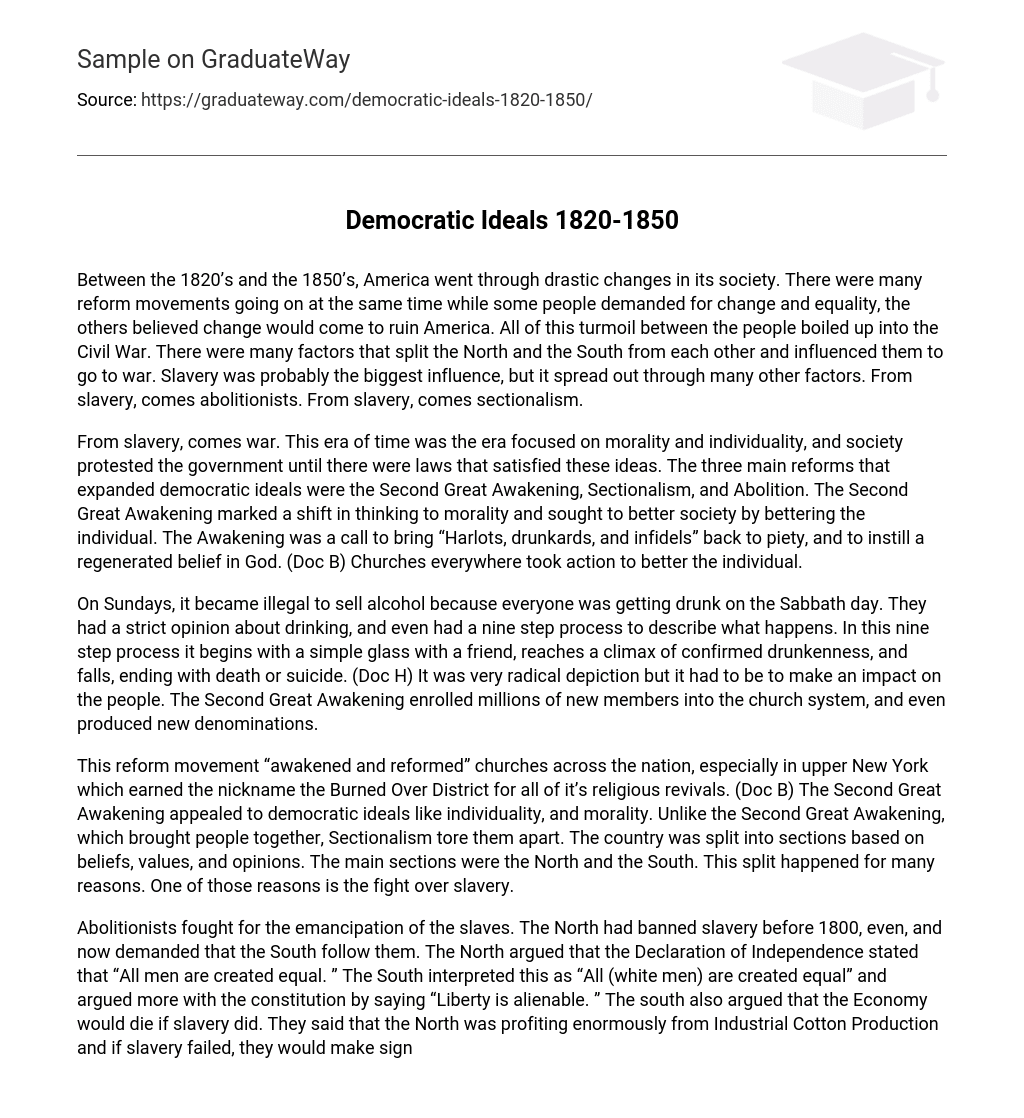During the 1820’s to the 1850’s, America underwent significant societal changes, marked by various reform movements. Despite some advocating for change and equality, others feared it would bring about the downfall of America. These tensions eventually culminated in the Civil War, fueled by numerous factors that divided the North and South and drove them to war. Although slavery played a central role, its impact encompassed several other aspects. Slavery gave rise to abolitionists and sectionalism.
From slavery, comes war. This era of time emphasized morality and individuality, leading society to protest the government until laws satisfying these ideals were established. The three main reforms that promoted democratic ideals were the Second Great Awakening, Sectionalism, and Abolition. The Second Great Awakening, aiming to improve society by improving individuals, resulted in a shift towards moral thinking. It called for the return of “Harlots, drunkards, and infidels” to piety and the restoration of faith in God. Churches worldwide took initiative to improve individuals.
On Sundays, the sale of alcohol was prohibited due to the excessive drinking that occurred on the Sabbath. The strict views on drinking were reflected in a nine step process that outlined its effects, starting from a casual drink with a friend and escalating to confirmed drunkenness, ultimately resulting in death or suicide (Doc H). This portrayal was radical but necessary to make an impression on the public. The Second Great Awakening led to a significant increase in church membership and gave rise to new denominations.
The reform movement known as the Second Great Awakening brought about awakening and reform in churches throughout the nation. This movement had a particularly significant impact on upper New York, which became known as the Burned Over District due to the numerous religious revivals it experienced. (Doc B) The Second Great Awakening was characterized by its appeal to democratic ideals like individuality and morality, and it fostered a sense of unity among people. However, in contrast to the unifying nature of the Second Great Awakening, sectionalism caused division among the population. The country became divided into different sections, primarily the North and the South, based on differing beliefs, values, and opinions. One of the key reasons for this division was the contentious issue of slavery.
The abolitionists advocated for the liberation of the slaves. The Northern states had already outlawed slavery prior to 1800 and were now insisting that the Southern states do the same. The North based their argument on the Declaration of Independence, which affirmed that “All men are created equal.” Conversely, the South interpreted this statement as “All (white men) are created equal” and countered by invoking the constitution and affirming that “Liberty is alienable.” Additionally, the Southern states contended that abolishing slavery would have dire consequences for their economy. They argued that the North was reaping substantial profits from Industrial Cotton Production, and if slavery were to be abolished, they would suffer a significant decline in earnings.
The South contended that the North relied on slavery as much as they did. They believed that they were steadfast followers of the founding fathers and remained true to the historical republican principles, while the North was susceptible to numerous “isms.” The nation was divided by the differing opinions of each side. The Abolitionist Crusade, which was the final movement to promote democratic ideals, maintained a democratic nature as it was voluntary, championed equality and free will, and advocated for freedom. Additionally, the movement provided opportunities for both free African Americans and women to take part.
One of the goals of the Crusade was to emancipate the slaves and transport them back to Monrovia. Although this radical idea never came to fruition, it effectively represents their beliefs. The North attempted to combat slavery by sending Abolitionist literature to the South, but it was met with resistance as it was simply burned. The North protested against both slavery and the denial of women’s rights, arguing that these laws were imposed “without the consent of the governed” and that the people were not “represented in the government which [they] are taxed to support” (Doc I). Document C highlights the perspectives of female slaves, who experienced particular oppression due to laws targeting both black individuals and women.
When the Abolitionists realized they couldn’t free the slaves, they instead advocated for the prevention of slavery’s expansion. After the Nat Turner rebellion, the South became fearful of further slave uprisings, leading them to implement laws that banned slave education, made slave relocation harder, and even offered a reward for the capture of the Abolitionist leader in Georgia. Their leader, William Lloyd Garrison, considered the abolition of slavery as the paramount concept in establishing an ideal society. All these reform movements advanced democratic principles.
During the pre-civil war era, America witnessed a transition towards individualism and morality, resulting in intense debates about equality and freedom. While the North embraced change to strengthen the country, the South clung to traditional republican values and opposed any form of change. The constant conflict between the two sides eventually culminated in the Civil War. These shifts paralleled the Market Revolution, where political dynamics had to adapt to societal changes. Similarly, in this context, society compelled the government to alter its approach due to a widespread desire for change.
People argued that these changes be made to promote equality and so that they “might feel a pride” in their country once again. (Doc A) Democratic ideals had to broaden immensely after this time period. Feelings of freedom and equality rang throughout the North and from the slaves. Slavery had become a political issue instead of just an economic or social one. America was changing fast and for the better. The Second Great Awakening, Sectionalism, and the Abolitionist’s Crusade all broadened democratic ideals and molded America into something brand new and different than it had ever been before.





